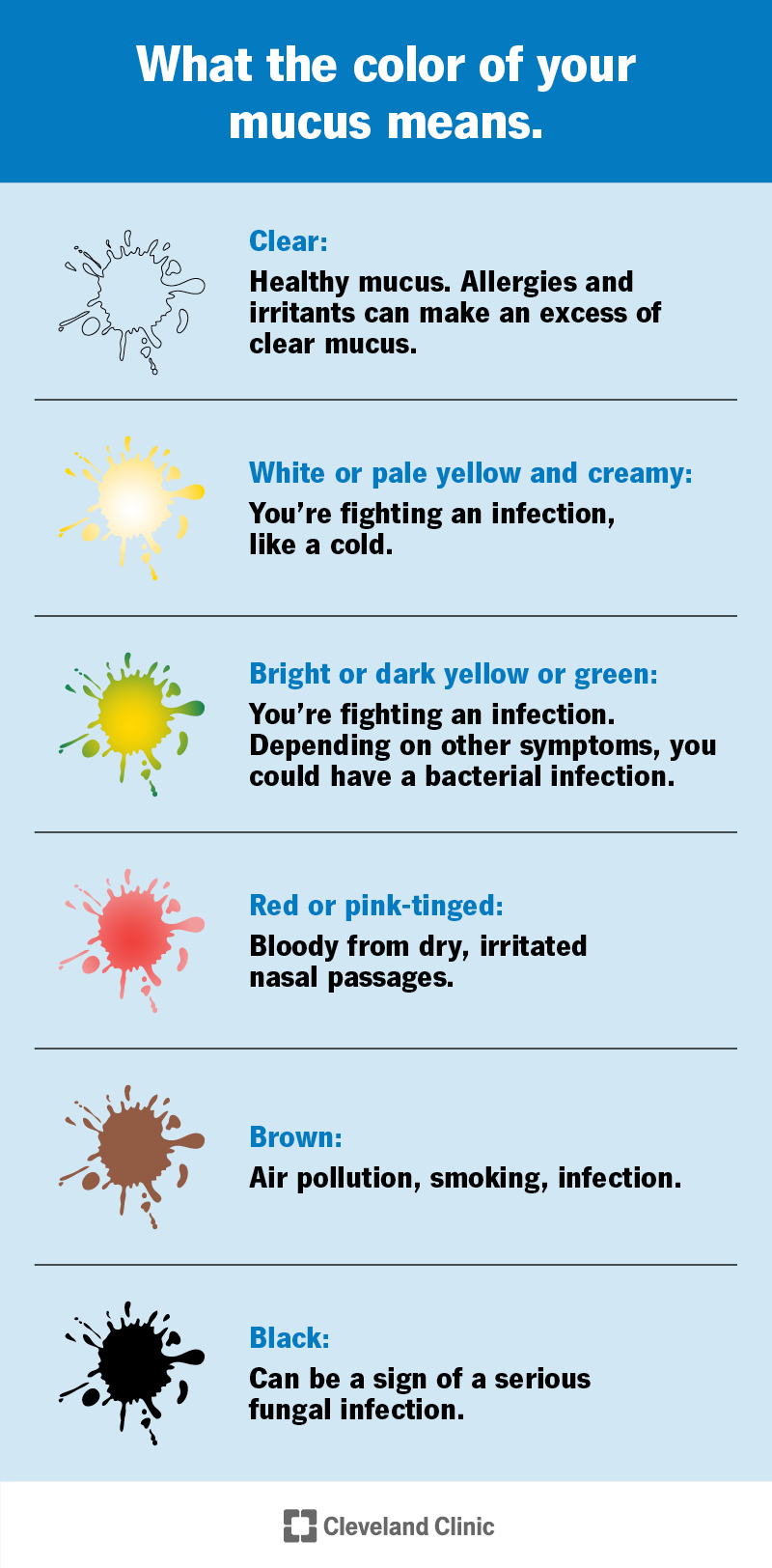Mucus is a clear, slippery, gel-like substance that’s part of your immune system. It lines your mucous membranes and helps trap and destroy or clear out germs and harmful particles. Mucus gets thick and sticky and might be white, yellow or green when you have an infection. It’s also called phlegm, snot or sputum.
Advertisement
Cleveland Clinic is a non-profit academic medical center. Advertising on our site helps support our mission. We do not endorse non-Cleveland Clinic products or services. Policy

Mucus is a slippery fluid that lines your respiratory, digestive, urinary and reproductive tracts. It acts like a shield to keep out harmful germs (pathogens) while also letting in things your body needs, like oxygen and nutrients. It also lubricates and moisturizes organs and structures in your body.
Advertisement
Cleveland Clinic is a non-profit academic medical center. Advertising on our site helps support our mission. We do not endorse non-Cleveland Clinic products or services. Policy
You might know mucus by one of its other names, like snot, phlegm or sputum. And you probably only think about it when you’re trying to get rid of it — like when there’s far too much mucus dripping from your nose or clogging your throat. But mucus is an important part of your immune system that’s constantly putting itself in harm’s way to keep you safe.
Mucus has a lot of important jobs, including:
Goblet cells — specialized epithelial cells that are shaped a bit like a fancy drinking glass — and other cells in your mucosa create mucin, the main component of mucus. Mucus lines your:
Advertisement
The “ingredients” that make up mucus give it its consistency and help protect you from germs. They include:
Mucus is usually clear, thin and slippery. If you have a respiratory or sinus infection, the mucus coming out of your nose or throat may be thick, sticky and creamy white. Dead cells, germs, tobacco smoke and other substances in your mucus can change its color. Mucus colors include:
Mucus color alone won’t tell you if you have a specific kind of infection. See a healthcare provider if you have dark-colored mucus — or any other color that concerns you — especially if you have other symptoms, like facial pain or headaches.
When you’re not sick, mucus is usually clear. Thick mucus that appears creamy, yellow or green could mean you have an infection. You might get a runny nose with large amounts of clear mucus if you have allergies.
Anything that causes inflammation or activates your immune system can change the amount, color or consistency of mucus in different parts of your body. Hormones and genetic conditions can also affect it. Conditions that affect your mucus include:
Advertisement
Most of the time, excess mucus is something you have to deal with when you’re sick, while your body tries to clear out germs and dead immune cells. Some treatments that can help with mucus include:
See a healthcare provider if you have mucus that’s an unusual color (like bright yellow or green), is very dark or has a lot of blood in it. They can determine whether you have an infection that needs treatment.
Phlegm is a type of mucus that you usually cough up from your lower respiratory tract. It’s typically thicker than normal mucus because it’s helping fight an infection.
If you cough up phlegm into your mouth, it won’t hurt you to swallow it. Some people find that this makes them cough or it feels like it gets stuck in their throat. Or, it just feels gross. In that case, it’s perfectly OK to spit out phlegm — as long as you’re being considerate of other people while doing it.
Advertisement
If you can, find a tissue or napkin so you can spit your mucus into it and throw it away. Then, be sure to wash your hands. If you don’t have a tissue, step away from others before spitting.
Mucus is an undervalued part of your immune system’s team. It might seem like it sits on the bench, waiting to be put in the game just to make you miserable when you’re sick. But actually, all that snot, phlegm and slime is always going to bat for you. It constantly works to protect your body from germs and other things that could hurt you.
Changes in your mucus can also sometimes alert you that something’s wrong. If you notice something seems off with your mucus — the color, the amount or the consistency — it’s always best to check with a healthcare provider. They’re there to help you sort out what’s expected and what’s cause for concern.
Advertisement
Breathing issues can affect your life in many ways. Cleveland Clinic’s respiratory therapy program treats your symptoms so you can feel better day to day.

Last reviewed on 09/18/2024.
Learn more about the Health Library and our editorial process.